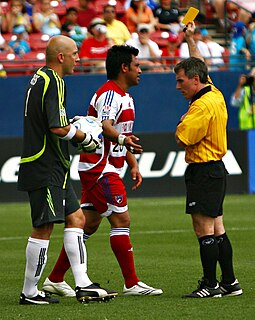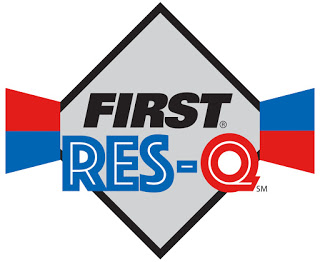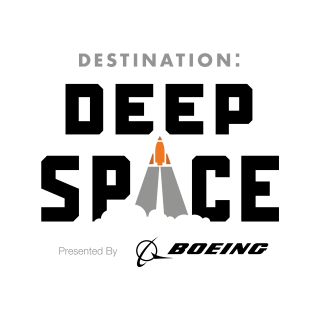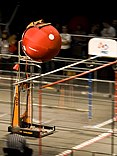Scoring
There were three sections to the game: the Autonomous Period, the Driver-Controlled (or Tele-Operated) Period, and the End Game. The criteria for scoring was different during each segment. [4]
- Autonomous Period
In the Autonomous Period, robots could run autonomously for thirty seconds. Infrared beacons were placed randomly on a peg in the tic-tac-toe board prior to the start of the match, but after autonomous programs have been selected. Each robot was allowed to begin with one specially-marked autonomous ring. Unscored rings were removed by referees after the end of the Autonomous Period. [1] An infrared sensor is available to aid in autonomously locating the IR beacon.
In development or moral, political, and bioethical philosophy, autonomy is the capacity to make an informed, un-coerced decision. Autonomous organizations or institutions are independent or self-governing. Autonomy can also be defined from human resource perspective and it means a level of discretion granted to an employee in his or her work. In such cases, autonomy is known to bring some sense of job satisfaction among the employees. Autonomy is a term that is also widely used in the field of medicine. As a matter of fact, personal autonomy is greatly recognized and valued in health care.

Infrared radiation (IR), sometimes called infrared light, is electromagnetic radiation (EMR) with longer wavelengths than those of visible light, and is therefore generally invisible to the human eye, although IR at wavelengths up to 1050 nanometers (nm)s from specially pulsed lasers can be seen by humans under certain conditions. IR wavelengths extend from the nominal red edge of the visible spectrum at 700 nanometers, to 1 millimeter (300 GHz). Most of the thermal radiation emitted by objects near room temperature is infrared. As with all EMR, IR carries radiant energy and behaves both like a wave and like its quantum particle, the photon.

A referee or simply ref is the person of authority in a variety of sports who is responsible for presiding over the game from a neutral point of view and making on-the-fly decisions that enforce the rules of the sport, including sportsmanship decisions such as ejection. The official tasked with this job may be known, in addition to referee, by a variety of other titles as well, including umpire, judge, arbiter, arbitrator, linesman, commissaire, timekeeper, touch judge or Technical Official.
| Method | Points |
|---|
| Scoring autonomous ring on the same column as the IR beacon | 50 points each |
| Scoring autonomous ring on any peg | "Ownership" of that peg |
- Driver-Controlled Period
During the two-minute Driver-Controlled Period, teams could use standard gamepad controllers, each with two joysticks, to operate their robots. [1]

A gamepad, joypad, or simply controller is a type of game controller held in two hands, where the fingers are used to provide input. They are typically the main input device for video game consoles.

A joystick is an input device consisting of a stick that pivots on a base and reports its angle or direction to the device it is controlling. A joystick, also known as the control column, is the principal control device in the cockpit of many civilian and military aircraft, either as a center stick or side-stick. It often has supplementary switches to control various aspects of the aircraft's flight.
| Method | Points |
|---|
| Scoring a ring on the center floor goal | 1 point each |
| Scoring a ring on the first level of the grid | 5 points each |
| Scoring a ring on the second level | 10 points each |
| Scoring a ring on the third level | 15 points each |
| Linear ring alignment (i.e. getting tic-tac-toe) | 30 points for each line |
| Scoring weighted ring in corner goal | 20% increase in points scored for rings |
- End Game
In FTC, the final thirty seconds of the Driver-Controlled Period are referred to as the End Game. During the Ring It Up! End Game, teams were permitted to attempt to score points for special tasks, but these tasks could not begin before the start of End Game. [1]
| Method | Points |
|---|
| Lifting alliance partner robot 1 inch off the floor tiles | 30 points; 5 points for each subsequent inch up to 24 inches |
Advancement criteria
During tournaments and championships, match wins did not necessarily take priority over other advancement criteria. As in all FTC challenges, the winner of the top judged award (the Inspire Award) ranked higher than the winner of the competition-based component (Winning Alliance Captain). [5] Winning lesser judged awards (Think Award, Connect Award, etc.) also played a part in the advancement order. The criteria for the Inspire Award are "...match performance, observations made during interviews and in the pit area, and the team’s Engineering Notebook as equal factors...". [6] Criteria for the other awards also include robot design, creativity, innovation, team performance, outreach and enthusiasm. [7]
For the Ring It Up! challenge, a new format for qualifying competitions was introduced in the United States regions for Florida, New Jersey, Pennsylvania, Washington, and St. Louis. Shorter competitions, called "meets", were held over weekends. Meets were smaller, shorter and more frequent than normal qualifying competitions. [8] This makes the format more accessible for new teams, in addition to providing more opportunities for structured practice in the company of other local teams. They were designed for participation more similar to participation in organised sport at the high school age. [9]

Rack 'n Roll was the game for the 2007 FIRST Robotics Competition season, announced on January 6, 2007. In it, two alliances of three teams each compete to arrange toroidal game pieces on a central arena element known as 'The Rack'.

Hangin'-A-Round was the name of the robotics contest at the 2006-2007 FIRST Vex Challenge. The contest involved building a robot from a kit that could attain a higher score than the opposition by placing the softballs into the colored goals, possessing the “atlas ball”, and by being parked on the platform or hanging from the bar.

In the 2007-2008 FIRST Tech Challenge robot competition, Quad Quandary is the first challenge theme replacing the former FIRST Vex Challenge, with similar general rules regarding the specifications of the robot and the game play. Unlike the previous challenge, Hangin'-A-Round, Quad Quandary makes use of small rings and movable goal posts.

The FIRST Championship is a four-day robotics championship held annually in April. For several years, the event was held at the Georgia Dome in Atlanta, Georgia, but moved to the Edward Jones Dome, in St. Louis, Missouri in 2011, where it remained through 2017. In 2017, the Championship was also held at the George R. Brown Convention Center and Minute Maid Park in Houston, Texas. From 2018 to 2020, the Championship will be held in Houston and Detroit, Michigan at the Cobo Center and Ford Field. The event comprises four competitions; the FIRST Robotics Competition Championship, the FIRST Tech Challenge World Championship, the FIRST Lego League World Festival, and the FIRST Lego League Junior World Expo.
The FIRST Championship is normally held in conjunction with the FIRST Robotics Conference, which covers a wide variety of topics in science, technology, engineering, and robotics fields.

Half-Pipe Hustle was the first official FIRST Vex Challenge (FVC) game, taking place in 2005-2006. In this challenge, robotics teams built robots from the Vex design kit to compete in competitions across the United States and in other nations, in matches consisting of a 45-second autonomous period, followed by a 2-minute operator control period in which the robots are controlled by remote control.

Hot Shot! is the robotics competition event in the 2009-2010 FIRST Tech Challenge. Two teams compete to score points by depositing whiffle balls into designated areas.

For Inspiration and Recognition of Science and Technology (FIRST) is an international youth organization that operates the FIRST Robotics Competition, FIRST LEGO League, FIRST LEGO League Jr., and FIRST Tech Challenge competitions.
Founded by Dean Kamen and Woodie Flowers in 1989, its expressed goal is to develop ways to inspire students in engineering and technology fields. Its philosophy is expressed by the organization as coopertition and gracious professionalism.
FIRST also operates FIRST Place, a research facility at FIRST headquarters in Manchester, New Hampshire, where it holds educational programs and day camps for students and teachers.
Get Over It! is the robotics competition event for the 2010-11 FIRST Tech Challenge. Two teams compete to score points by depositing colored batons in various types of goals. The name of the game refers to the many obstacles that traverse the middle of the field, which include a mountain, two bridges, and two ramps.

Logo Motion is the 2011 FIRST Robotics Competition game. Playing pieces are inner tubes shaped like the components of the FIRST logo. The primary objective of the game is to place them on racks to gain points. In the endgame, robots deploy smaller robots ("minibots") to climb a tower. Minibots must be made from the FIRST Tech Challenge kit of parts. The game celebrates the 20th season of the FRC and is also meant to commemorate the artist Jack Kamen, who designed the original FIRST logo.

Block Party!, released on September 7, 2013, is the 2013–2014 robotics competition for FIRST Tech Challenge. In the competition, two alliances, each consisting of two teams, compete to score blocks in plastic crates atop alliance-colored pendulums. Block Party! is the ninth FTC challenge.

Aerial Assist was the 2014 FIRST Robotics Competition game.

Recycle Rush was the 2015 FIRST Robotics Competition game. It involves picking up and stacking totes on scoring platforms, putting pool noodles ("litter") inside recycling containers, and putting the containers on top of scoring stacks of totes. There is also a coopertition aspect of the game where both alliances of teams can pool their totes and stack them on a step dividing the field to each gain twenty points. Along with these robot actions, human players can attempt to throw the pool noodles across the field to gain four points for each noodle left in the opposing alliance's work zone.
FIRST Stronghold was the 2016 FIRST Robotics Competition game. The game was played by two alliances of up to three teams each, and involves breaching the opponents’ defenses, known as outer work as well as capturing their tower by first firing "boulders" at it, and then surrounding or scaling the tower using a singular rung on the tower wall. Points were scored by crossing elements of the tower's outer works, shooting boulders into the opposing tower's five goals in order to lower the tower strength, and by surrounding and scaling the tower.

FIRST Res-Q, released on September 8, 2015, is the 2015–2016 robotics competition for FIRST Tech Challenge. In the competition, two alliances, each consisting of two teams, compete to climb a mountain and score debris in alliance specific goals. FIRST Res-Q is the eleventh FTC challenge game.

The VEX Robotics Competition is a robotics competition for elementary through university students. It is a subset of VEX Robotics, which is in turn a subset of Innovation First International. The VEX Robotics World Championship, run by the Robotics Education and Competition Foundation in April 2018 was named the largest robotics competition in the world by Guinness World Records.

FIRST Steamworks, stylized as FIRST STEAMworks, was the FIRST Robotics Competition game for the 2017 season. As in past games, two alliances of three individual teams and their robots compete on a field to score "match" point to win the game and ranking points to advance to playoff rounds. The game has a steampunk theme and teams are required to shoot wiffle balls which represent fuel into a simulated boiler which transfers the generated steam into an airship in the middle of the field. Each alliance has one airship, which they pressurize with steam from the boiler and load with plastic gears from the field. At the end of the match, robots can climb and hang on team-supplied ropes attached to the airship for additional points.

Destination: Deep Space, stylised as DESTINATION: DEEP SPACE and officially known as Destination: Deep Space Presented By The Boeing Company for sponsorship reasons is the FIRST Robotics Competition game for the 2019 season. It involves two alliances of three teams each, with each team controlling a robot and performing specific tasks on a field to score points. The game has an outer space theme and involves two alliances of three teams each competing to place hatch covers and rubber balls or "cargo" on rockets and cargo ships before returning to their hab platform to climb at the end of the match.

Rover Ruckus, officially known as Rover Ruckus Presented by Qualcomm for sponsorship reasons, is the FIRST Tech Challenge game for the 2018-2019 season. In the competition, two alliances of two teams each compete to collect minerals and place them into the cargo holes of the lander. Rover Ruckus is the fourteenth FTC game.
























